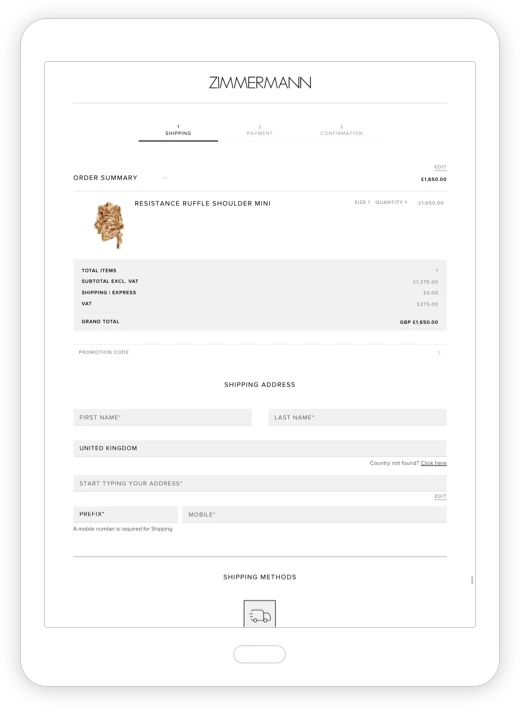The benefits of migrating to Magento 2
With the end of life date for Magento 1 (M1) quickly approaching (June 2020), it’s important for customers still using it to consider what their options are moving forward. With the help of our practice leads, we thought it would be useful to examine the maturing features of Magento 2 (M2) as well as the business considerations and practicalities that should be taken into account when making the move, across a two part series.
The benefits of Magento 2
Four years after M2 became generally available we’re seeing the benefits and ongoing enhancements of the platform make a difference to retailers. Having recently launched David Nieper, Zimmermann and Chi Chi onto M2, our practice review some of the developing M2 features that benefit retailers, brand owners and manufacturers making the switch.
Enhanced performance
Performance and page load times, particularly on mobile devices, has a huge impact on customer experience. Data from Cloudflare shows a correlation between load times and conversion rate while Google preferences stores with better load times, based on research suggesting up to 53% of mobile visitors will abandon pages with a load time greater than three seconds.
With M2, the homepage, category pages and product pages load in less than 1.5 seconds. While this is a big improvement in itself, the benefits continue across the entire store with overall load times of 30% to 50% faster than Magento 1.
Retailers are increasingly leveraging the Magento Performance Toolkit, available out-of-the-box in M2, to create tests and monitor performance. This enables retailers and their partners to create performance test scripts for greater reporting and visibility.
With an eye on mobile technology, Magento is continuing to push development of Progressive Web Apps, a type of web app that doesn’t need to be installed on a device to deliver experiences as rich as a native experience. The benefits of PWA include enabling rich interactions, increasing site speed and working offline or on low-quality networks.
Streamlined checkout
With M1, a customer was funnelled through six steps to complete their order – deciding on a checkout method, adding their billing information, shipping information, shipping method, payment information and finally reviewing their order.
With M2, the number of steps has been reduced to two – shipping and payments. This two-step process simplifies the checkout, reducing the complexity and number of clicks between a customer and a sale.
M2 also removes the need for customers to register before placing an order. This is a big win for customer experience as it reduces the actions a customer is forced to take before entering the checkout. Customers who have registered will automatically be identified at checkout based on their email addresses.
The result? End-to-end checkout times are 51% faster on M2, with corresponding improvements to customer experience.
The platform also introduces more ways for the customer to complete a purchase without entering the checkout. Using PayPal, customers can order directly from a product page or a product listing page, while “Instant Purchase” allows customers to use information saved to their account to make a purchase directly from the product page.

Enhanced merchandising and reporting
Product merchandising has been steadily improving in M2 with the ability to add product video and photography together on product pages. From start to finish the product upload process has been streamlined to make this regular task more manageable.
Merchandisers can also leverage personalisation features across the store, with the ability to create product up-sell and cross-sell recommendations, personalise payment methods for groups of customers, or even provide coupons based on user behaviour.
M2 boasts an enhanced reporting dashboard where you can find the most important information about your store’s performance. The dashboard gives you an overview of key metrics, including lifetime sales, average order amount, last orders, top search terms, most viewed products, new customers and more.
Improved search with Elasticsearch
A powerful, integrated search feature is important for all ecommerce retailers. Customers who use search while browsing an ecommerce store exhibit clear intent, with an opportunity to convert higher and purchase more. Studies suggest customers who interact with search on your store convert up to three times higher than those who only browse.
M1 has traditionally used the Solr search engine, which is still available but is being replaced by Elasticsearch. Elasticsearch can support 33 languages, allows multiple types of documents in an index, supports nested complex types and can be configured on the fly.
Elasticsearch comes as standard with Magento’s cloud offering.

Maturing extension landscape
Compared to M1.x versions, installing new extensions and modules is simpler and cheaper with M2. Installing even a few of the basic M1.x extensions can take a lot of time, even for professional developers, and introduces the possibility of conflicting extensions. The install, update and modification of extensions has become simpler thanks to the use of HTML5 in M2. As part of a commitment to making it easier to discover and work with extensions Magento created the Magento Marketplace. This is a store where retailers and their partners can review and purchase extensions for the platform. The Magento Marketplace reflects the positive relationship between the vendor and developers. Developers are able to sell and promote extensions while sharing the profits with Magento, while Magento runs quality assurance on vendor modules in order to ensure compatibility. Make sure you read our follow up piece which examines the practicalities and considerations when making the move to M2.Share on social